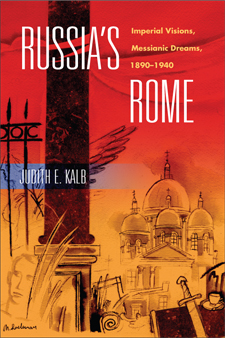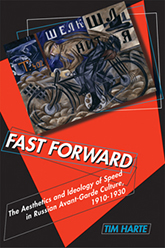|
Fast Forward
The Aesthetics and Ideology of Speed in Russian Avant-Garde Culture, 1910–1930
Tim Harte
“Presents a fresh and insightful approach to the whole phenomenon of avant-garde art forms in Russia.”
—Barry P. Scherr, Dartmouth College
Life in the modernist era not only moved, it sped. As automobiles, airplanes, and high-speed industrial machinery proliferated at the turn of the twentieth century, a fascination with speed influenced artists—from Moscow to Manhattan —working in a variety of media. Russian avant-garde literary, visual, and cinematic artists were among those striving to elevate the ordinary physical concept of speed into a source of inspiration and generate new possibilities for everyday existence.
Although modernism arrived somewhat late in Russia, the increased tempo of life at the start of the twentieth century provided Russia’s avant-garde artists with an infusion of creative dynamism and crucial momentum for revolutionary experimentation. In Fast Forward Tim Harte presents a detailed examination of the images and concepts of speed that permeated Russian modernist poetry, visual arts, and cinema. His study illustrates how a wide variety of experimental artistic tendencies of the day—such as “rayism” in poetry and painting, the effort to create a “transrational” language (zaum’) in verse, and movements seemingly as divergent as neo-primitivism and constructivism —all relied on notions of speed or dynamism to create at least part of their effects.
Fast Forward reveals how the Russian avant-garde’s race to establish a new artistic and social reality over a twenty-year span reflected an ambitious metaphysical vision that corresponded closely to the nation’s rapidly changing social parameters. The embrace of speed after the 1917 Revolution, however, paradoxically hastened the movement’s demise. By the late 1920s, under a variety of historical pressures, avant-garde artistic forms morphed into those more compatible with the political agenda of the Russian state. Experimentation became politically suspect and abstractionism gave way to orthodox realism, ultimately ushering in the socialist realism and aesthetic conformism of the Stalin years.
Tim Harte is assistant professor of Russian language and literature at Bryn Mawr College.
Praise
“As a compellingly argued study of an important aspect of modernity and its relationship to culture, Fast Forward will be of value to historians and critics of art, literature, film, or any other aspect of the Russian avant-garde. Beyond that, however, some of Harte’s more unexpected examinations might cause some readers to look at familiar works of art with new eyes.”
—Robert Crane, Slavic and East European Journal
“Harte demonstrates a keen, sophisticated, illuminating grasp of comparative literature in western Europe and of Albert Michelson’s, Edward Morley’s, and Albert Einstein’s theories of the speed of light. . . . An impressive, insightful analysis.”
—Choice
“The book is well-written and richly illustrated. It is a pleasure to read both in the old-fashioned slow way and to browse in the accelerated fast-forward mode. This highly stimulating study responds to a long-standing need to address speed as an aesthetic category in modern Russian art and constitutes a very welcome and important contribution to the field.”
—Nikolai Firtich, Slavic Review
A Mellon Slavic Studies Initiative Book
This book is part of a five-year initiative
for publishing first books by scholars in the fields of Russian, East European, and
Central Asian Studies, supported by the Andrew W. Mellon Foundation. |
Media & bookseller inquiries regarding review copies, events, and interviews can be directed to the publicity department at publicity@uwpress.wisc.edu or (608) 263-0734. (If you want to examine a book for possible course use, please see our Course Books page. If you want to examine a book for possible rights licensing, please see Rights & Permissions.)
Of Related Interest:
 Russia’s Rome Russia’s Rome
Imperial Visions, Messianic Dreams, 1890-1940
Judith E. Kalb
A wide-ranging study of empire, religious prophecy, and nationalism in literature, Russia’s Rome provides the first examination of Russia’s self-identification with Rome during a period that encompassed the revolutions of 1905 and 1917 and the rise of the Soviet state. |
|
|

November 2009
LC: 2009013797 N
330 pp. 6 x 9
8 color, 15 b/w illus.
|

